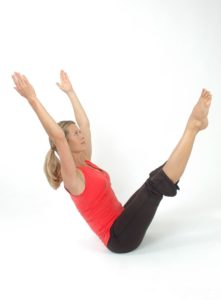 While many people automatically assume Yoga is the go-to for those with back problems, it’s sister workout, Pilates, doesn’t always get the attention it deserves. For me, Pilates was integral to my recovery and still is the main focal point of my routine now that I’m better.
While many people automatically assume Yoga is the go-to for those with back problems, it’s sister workout, Pilates, doesn’t always get the attention it deserves. For me, Pilates was integral to my recovery and still is the main focal point of my routine now that I’m better.
So once the initial inflammation phase of your injury is over, and you’re cleared to start moving again, before you hit the Yoga mat, I urge you to consider Pilates. But before you do, here are some things you should know:
What is Pilates?
Pilates is named for its creator, Joseph Pilates, who developed the exercises in the 1920s. Pilates not only fixes muscle imbalances, builds core strength, and improves flexibility, but its strategic focus is based on moving your spine in all six directions – all of which are critical for a healthy back.
Pilates is low-impact (so leave those sneakers at the door!) and combines flexibility, muscular strength, and endurance movements into one efficient workout. While many commercial fitness facilities have Pilates classes, anyone with an injury should consider pursuing a practice in a Pilates-specific studio with a trainer who specializes in sports/physical rehabilitations.
How Can Pilates Help Your Back?
Pilates focuses on the core postural muscles that help keep the body balanced and are essential to providing support for the spine. In particular, Pilates exercises teach awareness of neutral alignment of the spine (ie the most functionally ideal or “perfect” posture) and strengthening the deep postural muscles that support this alignment.
This concept is critically important for anyone with a back issue to understand and execute not just during their Pilates sessions, but in their daily lives. By implementing these techniques into your everyday life, which Pilates teaches you to do (and helps you obtain the muscle memory to keep doing it) you begin to fix the cause of your back problem, rather than only treat the symptoms.
How to Get Started With Pilates
I assume if you’re reading this, you have a back issue that you’re working through–therefore, I believe you would benefit from several one-on-one Pilates sessions with a certified, vetted Pilates instructor who specializes in rehabilitative Pilates. Note: many Stott-certified Pilates instructors hold this designation…you just need to do your research!
While a private session is more expensive than a group class class, the time, money, and effort devoted to learning the exercises correctly is well worth the investment (and just like anything else, after a while you will get good at it and may develop the ability to do a lot of the exercises at home). Remember: exercises performed incorrectly can make a back problem worse.
When I was first cleared for activity, I did twice-a-week, private sessions on a reformer (a fancy piece of equipment that most Pilates-specific studios have) with a Stott-certified trainer who specializes in back injury rehabilitation. After about four months, I scaled down to one private session a week, but added a reformer-based group class to the mix (these classes are small, 4-6 people). Now, that I’m stronger than I’ve ever been (thank you Pilates!), I do weekly group reformer sessions with the same crew every week, and then do my own exercises at home another 2-3 days a week.
Onward and Upward
Pilates was a key component to my back healing recovery, and now, it’s a part of my regular routine and daily life. While the investment up front was considerable, it proved to be worth it for me, and every penny was well spent. There was nothing about my healing journey that was conventional, so this should come as no surprise that I opted for Pilates over Physical Therapy (no, I’m not rich by any means and No, Pilates was not covered by my insurance, but PT would have been – so what does that tell you? Lol).
However, I urge you to follow your instincts and choose the path that is right for you. I don’t believe it needs to be a “one or the other” thing, you can always do a combination of both and see how you feel and how you progress. And of course, as always, make sure to consult with your doctor or specialist before beginning any new exercise program.
You’ve got this, and I’ve got your back (no pun intended)!
Xo,
Christa D.